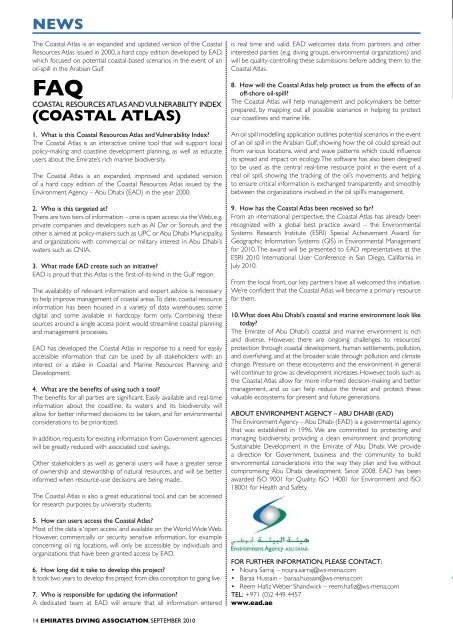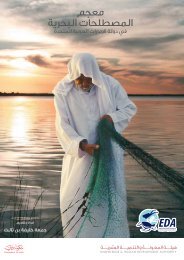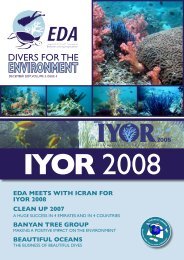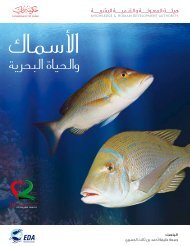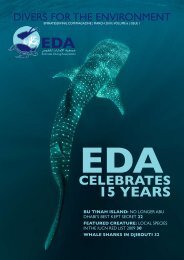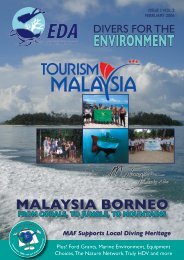NEWS - Emirates Diving Association
NEWS - Emirates Diving Association
NEWS - Emirates Diving Association
Create successful ePaper yourself
Turn your PDF publications into a flip-book with our unique Google optimized e-Paper software.
<strong>NEWS</strong><br />
The Coastal Atlas is an expanded and updated version of the Coastal<br />
Resources Atlas issued in 2000, a hard copy edition developed by EAD,<br />
which focused on potential coastal-based scenarios in the event of an<br />
oil-spill in the Arabian Gulf.<br />
FAQ<br />
COASTAL RESOURCES ATLAS AND VULNERABILITY INDEX<br />
(COASTAL ATLAS)<br />
1. What is this Coastal Resources Atlas and Vulnerability Index?<br />
The Coastal Atlas is an interactive online tool that will support local<br />
policy-making and coastline development planning, as well as educate<br />
users about the Emirate’s rich marine biodiversity.<br />
The Coastal Atlas is an expanded, improved and updated version<br />
of a hard copy edition of the Coastal Resources Atlas issued by the<br />
Environment Agency – Abu Dhabi (EAD) in the year 2000.<br />
2. Who is this targeted at?<br />
There are two tiers of information – one is open access via the Web, e.g.<br />
private companies and developers such as Al Dar or Sorouh, and the<br />
other is aimed at policy-makers such as UPC or Abu Dhabi Municipality,<br />
and organizations with commercial or military interest in Abu Dhabi’s<br />
waters such as CNIA.<br />
3. What made EAD create such an initiative?<br />
EAD is proud that this Atlas is the first-of-its-kind in the Gulf region.<br />
The availability of relevant information and expert advice is necessary<br />
to help improve management of coastal areas. To date, coastal resource<br />
information has been housed in a variety of data warehouses; some<br />
digital and some available in hardcopy form only. Combining these<br />
sources around a single access point would streamline coastal planning<br />
and management processes.<br />
EAD has developed the Coastal Atlas in response to a need for easily<br />
accessible information that can be used by all stakeholders with an<br />
interest or a stake in Coastal and Marine Resources Planning and<br />
Development.<br />
4. What are the benefits of using such a tool?<br />
The benefits for all parties are significant. Easily available and real-time<br />
information about the coastline, its waters and its biodiversity, will<br />
allow for better informed decisions to be taken, and for environmental<br />
considerations to be prioritized.<br />
In addition, requests for existing information from Government agencies<br />
will be greatly reduced with associated cost savings.<br />
Other stakeholders as well as general users will have a greater sense<br />
of ownership and stewardship of natural resources, and will be better<br />
informed when resource-use decisions are being made.<br />
The Coastal Atlas is also a great educational tool, and can be accessed<br />
for research purposes by university students.<br />
5. How can users access the Coastal Atlas?<br />
Most of the data is ‘open access’ and available on the World Wide Web.<br />
However, commercially or security sensitive information, for example<br />
concerning oil rig locations, will only be accessible by individuals and<br />
organizations that have been granted access by EAD.<br />
6. How long did it take to develop this project?<br />
It took two years to develop this project from idea conception to going live.<br />
7. Who is responsible for updating the information?<br />
A dedicated team at EAD will ensure that all information entered<br />
is real time and valid. EAD welcomes data from partners and other<br />
interested parties (e.g. diving groups, environmental organizations) and<br />
will be quality-controlling these submissions before adding them to the<br />
Coastal Atlas.<br />
8. How will the Coastal Atlas help protect us from the effects of an<br />
off-shore oil-spill?<br />
The Coastal Atlas will help management and policymakers be better<br />
prepared, by mapping out all possible scenarios in helping to protect<br />
our coastlines and marine life.<br />
An oil spill modelling application outlines potential scenarios in the event<br />
of an oil spill in the Arabian Gulf, showing how the oil could spread out<br />
from various locations, wind and wave patterns which could influence<br />
its spread and impact on ecology. The software has also been designed<br />
to be used as the central real-time resource point in the event of a<br />
real oil spill, showing the tracking of the oil’s movements and helping<br />
to ensure critical information is exchanged transparently and smoothly<br />
between the organizations involved in the oil spill’s management.<br />
9. How has the Coastal Atlas been received so far?<br />
From an international perspective, the Coastal Atlas has already been<br />
recognized with a global best practice award – the Environmental<br />
Systems Research Institute (ESRI) Special Achievement Award for<br />
Geographic Information Systems (GIS) in Environmental Management<br />
for 2010. The award will be presented to EAD representatives at the<br />
ESRI 2010 International User Conference in San Diego, California in<br />
July 2010.<br />
From the local front, our key partners have all welcomed this initiative.<br />
We’re confident that the Coastal Atlas will become a primary resource<br />
for them.<br />
10. What does Abu Dhabi’s coastal and marine environment look like<br />
today?<br />
The Emirate of Abu Dhabi’s coastal and marine environment is rich<br />
and diverse. However, there are ongoing challenges to resources’<br />
protection through coastal development, human settlements, pollution,<br />
and overfishing, and at the broader scale through pollution and climate<br />
change. Pressure on these ecosystems and the environment in general<br />
will continue to grow as development increases. However, tools such as<br />
the Coastal Atlas allow for more informed decision-making and better<br />
management, and so can help reduce the threat and protect these<br />
valuable ecosystems for present and future generations.<br />
About Environment Agency – Abu Dhabi (EAD)<br />
The Environment Agency – Abu Dhabi (EAD) is a governmental agency<br />
that was established in 1996. We are committed to protecting and<br />
managing biodiversity, providing a clean environment and promoting<br />
Sustainable Development in the Emirate of Abu Dhabi. We provide<br />
a direction for Government, business and the community to build<br />
environmental considerations into the way they plan and live without<br />
compromising Abu Dhabi development. Since 2008, EAD has been<br />
awarded ISO 9001 for Quality; ISO 14001 for Environment and ISO<br />
18001 for Health and Safety.<br />
For Further Information, please Contact:<br />
• Noura Sarraj – noura.sarraj@ws-mena.com<br />
• Baraa Hussain – baraa.hussain@ws-mena.com<br />
• Reem Hafiz Weber Shandwick – reem.hafiz@ws-mena.com<br />
Tel: +971 (0)2 449 4457<br />
www.ead.ae<br />
14 EMIRATES DIVING ASSOCIATION, SEPTEMBER 2010 SEPTEMBER 2010, EMIRATES DIVING ASSOCIATION 15


